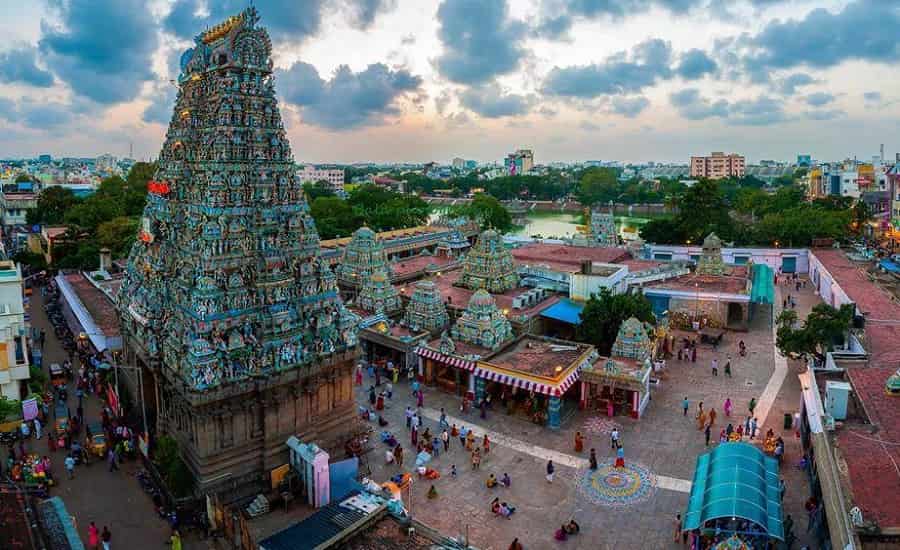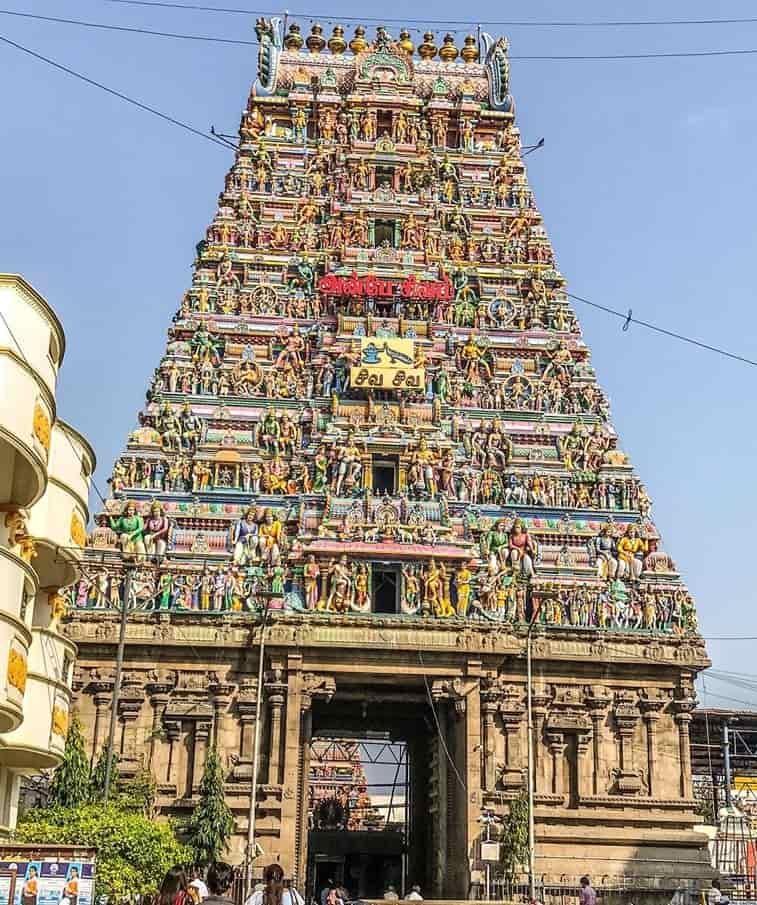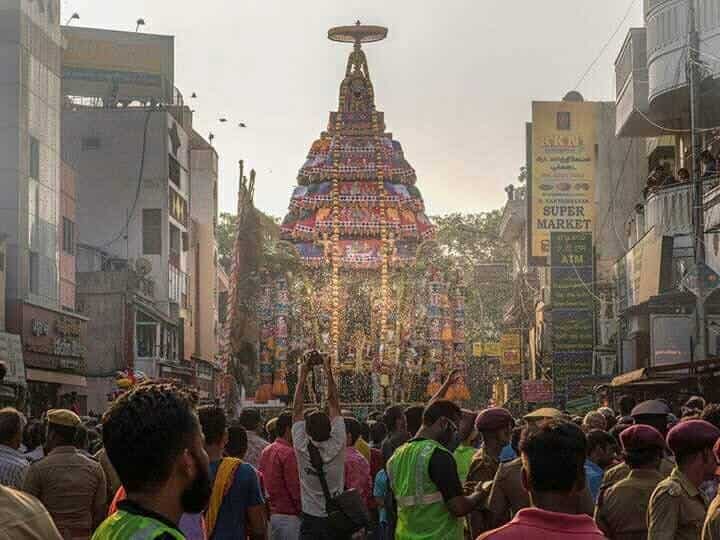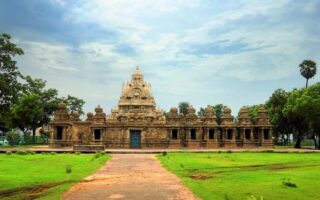There is always a way of advertising our emotions and dedication for something. It is not always through words that we are able to convey what we truly feel. We take refuge in other ways of communicating our state of mind which are sometimes more powerful than the words. Following this notion, the people in ancient India constructed temples to showcase their dedication and faith in a supreme being. This notion led to the construction of Kapaleeshwarar Temple in Tamil Nadu, a 7th century structure dedicated to Lord Shiva. It has now become a heritage site and a place where several devotees gather on regular days and during festivals as well.

Location
The historical Kapaleeshwarar Temple is located in the Mylapore neighbourhood of Chennai, the capital city of Tamil Nadu.
History
The credit of constructing this temple is given to the rulers of the Pallava Dynasty. It is said that the temple was built in the 7th century, primarily due to the mentions of the temple in ancient hymns and songs. However, the catch here is the appearance of the temple, which raises doubt regarding the period of construction. Its architecture looks no more than 400 years old.
Historians opine that the original temple might have been demolished by the Portuguese people, and the temple that we see today was built in the 16th century. Another argument is raised by the inscriptions found inside the temple, dated back to the 12th century. The only feature of the temple which is not argued upon is the gateway tower, a 120 feet high structure added to the temple complex in 1906.
A legend goes that the during a conversation between Lord Shiva, Lord Brahma and Lord Vishnu atop the Kailash Parbat, the abode of Shiva, Brahma said something which angered Shiva who cut off one of Brahma’s head.
Brahma, as a measure to please Shiva, came to the temple site where he installed a Shivlinga. The site is also known as Veda Puri and Sakra Puri and has been compared to the original abode of Shiva, the Kailash Parbat.
Other legends associated with the temple site include blessings bestowed upon several devotees by Lord Shiva himself.
In the present day temple, visitors can spot a male and a female peacock (peahen) inside a cage. The peacocks symbolize Shakti, who manifested into a peahen to worship Lord Shiva.
Structure
This ancient temple is built in the Dravidian architectural style, with two entrances. A tank can be spotted adjacent to the western entrance of the temple. Both the entrances of the temple are through a Gopuram, with the eastern standing at a height of approximately 40 metres.

There are statues of vehicles of Gods, including that of a Nandi, Adhikaranandi, bandicoot, goat, parrot and an elephant. The idols of Gods are placed over their respective vehicles. A golden chariot has also been installed recently.
Festivals and Traditions
Like all other historical temples, the Kapaleeshwarar temple witnesses devotees gathering in large numbers for worship. Every Friday, devotees gather at the temple and decorate the idol of Karpagambal, an avatar of Parvati, with a gold coin studded garland.
Before the worship, a musical procession is carried out with the idols of the temple God and Goddess seated on their vehicles. Pulling the vehicles is considered to be a privilege by the devotees.

Temple rituals include four pujas held in the morning, afternoon, evening and night.
The annual festival of Brahmaotsavam is held between mid-March to mid-April during which a carnival of devotees energizes the environment with religious vibes. The festival is marked by flag hoisting, followed by the decoration of idols with jewellery and clothes. The idols are placed on their vehicles and pulled by the devotees around the temple for the next few days. The festival concludes with the marriage of the idols.
An Aarti is performed during each stage of the festival and the devotees are offered sweets, buttermilk, juices and savories.
Eat, Drink, Collect
After visiting the historical Kapaleeshwarar temple, visitors can head to the nearby area of Mylapore to have a meal, snacks, or fast food as per their choice. Famous outlets that serve food and snacks include Karpagambal Mess, Coastline, Anjappar, Karaikudi, Citrus, etc.
There are a number of mid-range hotels and lodges in the area which provide comfortable stay and other normal services as well.
Visitors can purchase accessories, costumer, jewellery and other goodies from the shops and vendors near the temple itself. Other shops in the area sell local handicrafts and fashion accessories that are worth collecting.
As a prime commercial centre of Chennai, the neighborhood of Mylapore boasts several outlets, exhibition halls and a shopping mall which serve the recreational requirements of the tourists.
The notable outlets of Mylapore include Alwar’s Roadside Bookshop, Ashvita Arts and Artifacts, Crafts and Weaves, Giri Stores, etc.
Travel Tips
Always bargain for whatever you purchase from the vendors and local outlets. Tourists might be overcharged, as they board auto-rickshaws.
Always carry bottled water with you, as the water served in local eateries may not be suitable for consumption. Due to the hot and humid weather of Chennai, tourists must carry an umbrella and keep drinking small amount of water to avoid any instance of dehydration.
Nearby Attractions
Apart from the historical temple, Mylapore is also known for several other destinations of tourist interest. Other tourist attractions with historical significance in the vicinity include the San Thome Basilica, Adikeshava Perumal Temple, Ramakrishna Math, Navashakti Vinayaka Temple, Madhava Perumal Temple, Malleshwarar Temple, etc.
How to Reach
The city of Chennai is served by an international airport and a busy railway station that connect the town with several parts of India and the world.
Once the tourists reach Chennai, they can opt to travel through MTC buses to visit the historical temple or board a train from Velachery or Chennai Beach junctions to reach Mylapore.


